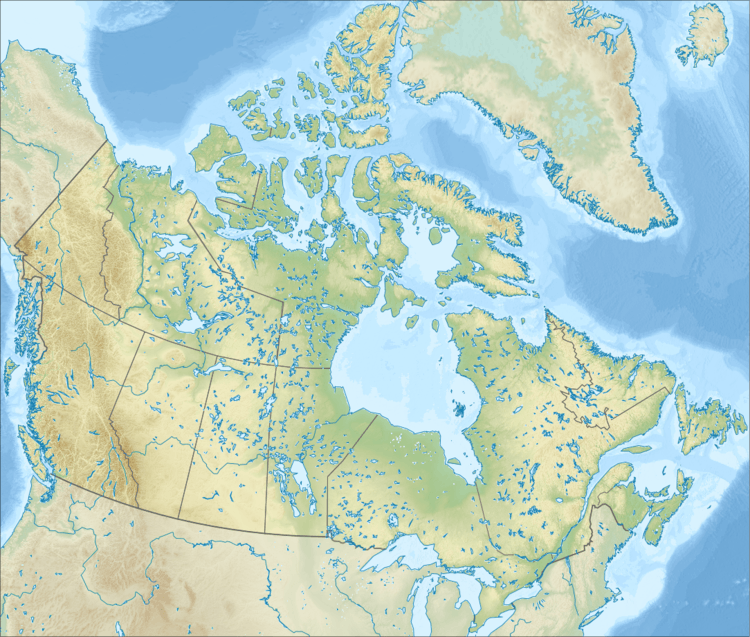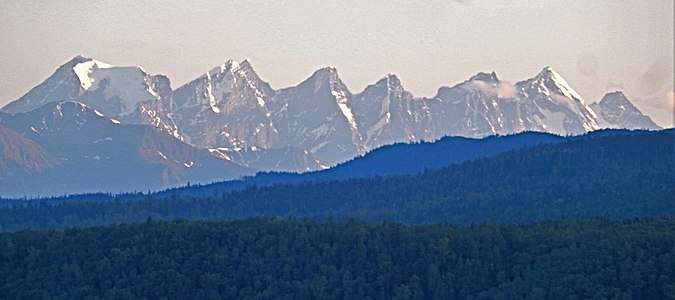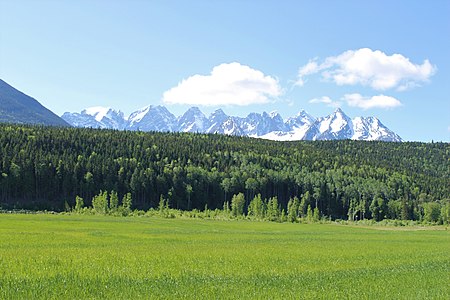Seven Sisters Peaks
Seven Sisters Peaks is a 2,747-metre (9,012-foot) multi-summit massif located in the Bulkley Ranges of the Interior Mountains in British Columbia, Canada. The massif is situated within Seven Sisters Provincial Park and Protected Area, 10 km (6 mi) southeast of Cedarvale, south of Orion Peak, and surrounded by Seven Sisters Glacier. The highest peak of the seven is called Weeskinisht Peak. Precipitation runoff from the mountain and meltwater from the glacier drains into tributaries of the Skeena River. The nearest higher peak is Howson Peak, 68.8 km (43 mi) to the south-southeast.[1] Based on the Köppen climate classification, Seven Sisters Peaks is located in a subarctic climate zone with cold, snowy winters, and mild summers.[4] Temperatures can drop below −20 °C with wind chill factors below −30 °C. Seven Sisters Mountain was the name adopted in 1948, but the mountain's name was changed and officially adopted October 4, 1951, by the Geographical Names Board of Canada.[2]
| Seven Sisters Peaks | |
|---|---|
 Seven Sisters Peaks (plus Orion Peak) | |
| Highest point | |
| Elevation | 2,747 m (9,012 ft) [1] |
| Prominence | 1,862 m (6,109 ft) [1] |
| Parent peak | Howson Peak |
| Listing | |
| Coordinates | 54°58′25″N 128°12′39″W [2] |
| Geography | |
 Seven Sisters Peaks Location of Seven Sisters Peaks in British Columbia  Seven Sisters Peaks Seven Sisters Peaks (Canada) | |
| Location | Seven Sisters Provincial Park British Columbia, Canada |
| Parent range | Bulkley Ranges Hazelton Mountains Interior Mountains |
| Topo map | NTS 103I/16 |
| Climbing | |
| First ascent | 1941 Neal Carter, K. Carter, G. Baker, J. Cade[3] |
The individually named peaks of the massif from west to east are Tlooki Peak, Weeskinisht Peak, Tagai Peak, Tingi Peak, Kitshin Peak, Kletoosho Peak, and Tuatoosho Peak, which are the Tsimshian/Gitxsan words for One, "Top of the Mountain", Three, Four, Five, Six, and Seven, respectively. With the exception of Weeskinisht, the other names were submitted by Neal M. Carter of the Alpine Club of Canada and officially adopted in 1977.[5]
Summits of Seven Sisters Peaks
| Name | Elevation | Prominence | First ascent | Reference |
|---|---|---|---|---|
| Tlooki Peak | 2571 m | 121 m | 1958 Chris Mair | [6] |
| Weeskinisht Peak | 2747 m | 1862 m | 1941 Neal Carter | [3] |
| Tagai Peak | 2660 m | 130 m | 1962 Brown, Shives | [7] |
| Tingi Peak | 2534 m | 49 m | [8] | |
| Kitshin Peak | 2580 m | 170 m | [9] | |
| Kletoosho Peak | 2597 m | 207 m | [10] | |
| Tuatoosho Peak | 2621 m | 251 m | [11] |
References
- "Seven Sisters Peaks, British Columbia". Peakbagger.com. Retrieved 2019-12-08.
- "Seven Sisters Peaks". Geographical Names Data Base. Natural Resources Canada. Retrieved 2019-12-09.
- "Weeskinisht Peak (Seven Sisters)". Bivouac.com. Retrieved 2019-12-09.
- Peel, M. C.; Finlayson, B. L. & McMahon, T. A. (2007). "Updated world map of the Köppen−Geiger climate classification". Hydrol. Earth Syst. Sci. 11: 1633–1644. ISSN 1027-5606.
- "Seven Sisters Peaks". BC Geographical Names.
- "Tlooki Peak (Seven Sisters Peaks)". Bivouac.com. Retrieved 2019-12-09.
- "Tagai Peak (Seven Sisters Peaks)". Bivouac.com. Retrieved 2019-12-09.
- "Tingi Peak (Seven Sisters Peaks)". Bivouac.com. Retrieved 2019-12-09.
- "Kitshin Peak (Seven Sisters Peaks)". Bivouac.com. Retrieved 2019-12-09.
- "Kletoosho Peak (Seven Sisters Peaks)". Bivouac.com. Retrieved 2019-12-09.
- "Tuatoosho Peak (Seven Sisters Peaks)". Bivouac.com. Retrieved 2019-12-09.
Gallery
(1).jpg) Seven Sisters Peaks seen with Orion Peak (furthermost right), and Skeena River
Seven Sisters Peaks seen with Orion Peak (furthermost right), and Skeena River Left to right: Tuatoosho, Kletoosho, Kitshin, Tingi, Tagai, Weeskinisht, Tlooki. From north
Left to right: Tuatoosho, Kletoosho, Kitshin, Tingi, Tagai, Weeskinisht, Tlooki. From north The peaks as seen from the Yellowhead Highway and Skeena River
The peaks as seen from the Yellowhead Highway and Skeena River
External links
- BC Parks: Seven Sisters Provincial Park
- Flickr photo: Seven Sisters Peaks aerial
- Flickr photo: South aspect
- Seven Sisters Peaks: Weather